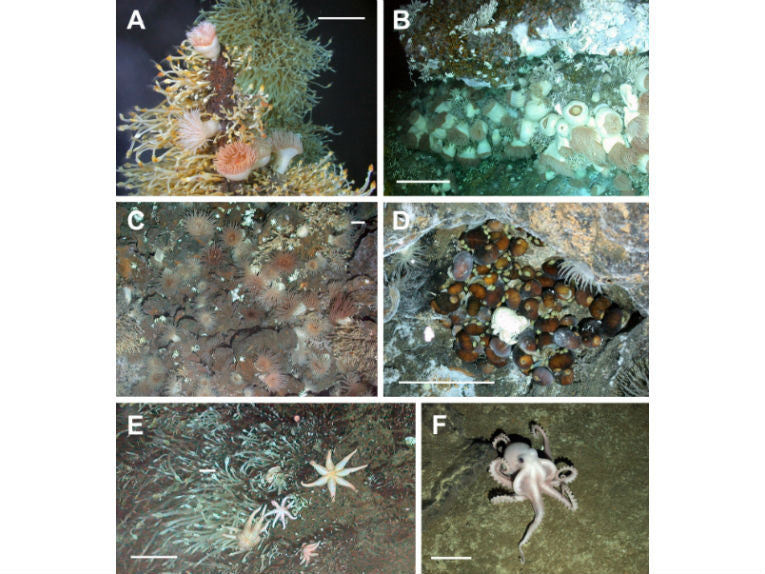(A) Actinostolid sea anemones surrounded by cf. Vulcanolepas on a chimney with diffuse hydrothermal venting at E9 (Dive 138, 2,396 m depth). (B) Dense field of actinostolid sea anemones along with peltospiroid gastropods (Dive 140, 2,394 m depth). (C) Anemone field at E9 with juvenile crab Kiwa n. sp. interspersed (Dive 139, 2,398 m depth). (D) Undescribed peltospiroid gastropod at E2 surrounding single crab Kiwa n. sp. and partially covered by Lepetodrilus n. sp. The pycnogonid cf. Sericosura is at the bottom right of the image (Dive 132, 2,608 m depth). (E) An undescribed seven-arm sea star predatory on the stalked barnacles cf. Vulcanolepas at E9 (Dive 139, 2,402 m depth). (F) The "cute" octopus was unfortunately unidentified at E9 (Dive 144, 2,394 m depth). Scale bars: 10 cm for foreground. doi:10.1371/journal.pbio.1001234.g003 (E2 and E9 are the two ESR sites mentioned)
It is amazing that we only finally confirmed chemosynthetic bacteria forming the basis of a whole ecosystem in 1977. Now a huge international contingent have contributed a paper on how recent discoveries have affected our limited knowledge of the deep-sea fauna of vents and their environmental hazards.
Alex D. Rogers from the University of Oxford's Zoology department and many others including American, Spanish and Portuguese researchers from Centro de Estudos do Ambiente e do Mar, Departmento Biologia, Universidade de Aveiro, Aveiro have contributed an essential document for the planet, never mind the dark abysses of which they speak!
The Galapagos trench and many other Pacific, Indian Ocean (possibly related to a SW Pacific biogeographic province) and mid-Atlantic trenches have been slowly "unearthed", until recently the faunal diversity was found to be centred on the Antarctic Ocean. With this lead, the East Scotia Ridge (ESR) there was explored, with the typical smokers found in two areas at below 2300m.
The crabs, gastropods, limpets anemones and a single sea star species were simply a small number of the Arthropod, Mollusc, Echinoderm and Coelenterate representatives present. Polychaete worms, various mussels and certain shrimps which are expected elsewhere were however absent.
A new species of yeti crab (Kiwa sp.) seems dominant in many communities, near the vents' chimneys, and has handy filaments which could be harbouring chemosynthetic bacteria that would give it it omnivorous potential. The crab occupies a niche similar to that of the absent Polychaete worms. The authors are keen on establishing these ESR areas as a new bio-geographic province.
As sulphur( as H2S) is the the major chemosynthetic source material, scientists regard the isolated vent communities as good research material to be compared with early life form and even alien biologies beyond the earth. Evolution can easily be studied among these deep-sea "islands" of chemosynthesis too.
Remote vehicles have to be employed and cameras with grab apparatus or water column sampling are the only tools. They found none of the dominant spp. Normally associated with the main ocean vents and the yeti crabs here are almost unique to the bio-geographic area. Species disperse along the ocean ridge systems, as proved by genetic differentiation studies, but it is likely that larvae can spread using deep sea currents.
Whale falls provide nutrition where no other is available, aiding dispersive animals in their route to distant smokers. A major geographical barrier is the Polar Front. This top to bottom ridge can prevent deep water species from readily leaving the area. Cold water affects crab physiology while the Arctic shrimp and mussel fauna is similarly blocked by the low temperature.
The lack of Antarctic crab and shrimp spp. can be explained by the mountainous Polar Front All of the evidence points to new research, using the specially built research vessels. The rewards are further conservation information with multiple benefits.
While we benefit little from the community down there, they certainly change little, from past evidence, and could be easily destroyed by a classic human dump! With the Moon and Mars on our horizons, perhaps we could practice our ability to protect delicate environments with the equally elusive but much closer habitat below our oceans.
href="https://earthtimes.org/index.html">Homepage









